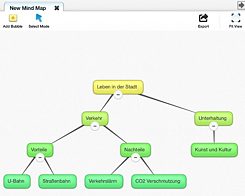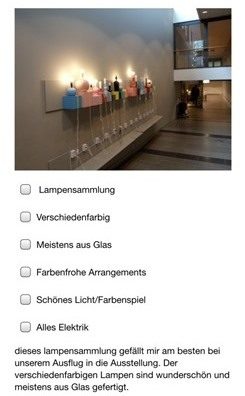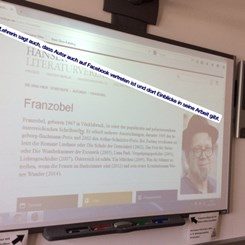Mobile learning in GFL lessons
Smartphones, tablets and the like

Many teachers and parents take a generally dim view of mobile phones in school. And yet such mobile devices can provide educational opportunities and enrich GFL lessons. Here are some practical examples and application scenarios.
The mobile learning approach is becoming increasingly important, partly thanks to the fast and inexpensive access to the Internet that is generally available, above all in Central Europe and the Anglo-Saxon world. Using their smartphones or tablet computers, learners are constantly able to access, edit, archive and use their data from just about anywhere, for example for Google Maps, to search for a restaurant online, to stream audio and video or for e-portfolios. Mobile phones are a contemporary and omnipresent tool in the lives of young learners. What is more, almost all families have a mobile phone and access to the Internet, as the JIM study shows (Feierabend, Plankenhorn, Rathgeb 2014).
Since mobile phones and tablets are an integral part of life for many young people, teachers and parents should give mobile learning in the educational context a chance. Much can be achieved, especially in terms of motivation, by using popular media. The use of such devices is no longer restricted to the classroom or computer room. This liberates learners from rigid, fixed-site learning spaces and contexts and allows them to embrace more mobile ones (cf. Wiley 2009). Furthermore, cloud computing allows quick, mobile, ubiquitous and on-demand access to all kinds of data.
Mobile phones thus offer personal and constant availability; considerable storage capacity for a diverse range of presentation forms; active media functions for videos, photographs, music and audio; applications for everyday organization such as calendars, alarms and navigation; access to many forms of personal communication (WhatsApp, Facebook, phone), as well as an interface and access to the Internet with its specific communication functions and its information and media archives, plus an interface function via Bluetooth or WiFi and a connection to an interactive whiteboard (Friedrich/Bachmair/Risch 2011, 11).
Didactic parameters for planning and analysing lesson units
The six didactic parameters defined by Bachmair (ibid., 9) are suitable for planning and analysing lesson units with mobile devices.
Integrate informal learning into the school environment: Mobile phones allow informal learning and everyday knowledge to be incorporated into school life. The mobile device can serve as an interface between youth culture, everyday life and targeted learning in the classroom.
Create episodes of situated learning: Thanks to its wide range of possible uses, mobile phones can support situated learning. For example, the lesson given by the teacher can be combined with episodes of mobile phone-based pupil activities.
Generate learning and media contexts: A mobile phone allows learners and teachers to create new learning contexts; these are generated at the point of intersection between media convergence on the Internet and entertainment media in everyday life and at school. This may also include situations outside the school setting.
Create bridges and chains of communication: Mobile phones can create bridges and chains of communication linking everyday life and school.
Allow pupils, as experts in their everyday lives, to become active in school on an individual basis: Many pupils these days are expert mobile phone users and know how to use their mobile device for school and non-school learning.
Create sensitive contexts for development and learning: The mobile artefacts generated by children, such as videos, chats and photographs, “are closely related to their personal development issues and can be usefully integrated into the learning situation” (ibid., 9).
Practical application scenarios for mobile devices in GFL lessons
On the basis of the above parameters, an overview of four basic practical application scenarios for mobile devices in GFL lessons will now be presented. Considerable importance is attached in the mobile context to the interplay between formal learning, such as that which takes place in schools, and informal learning, such as that which takes place at home or while out and about. In this context, Specht/Ebner/Löcker (2013) (referring to So/Kim/Looi, 2008) distinguish between four basic types:
Type I: Intended learning in class
These are conventional mobile learning situations within the classroom.
 Mind map
| © Thomas Strasser
Mind map
| © Thomas Strasser
Possible didactic scenario: working together, pupils use an app in the classroom to create a mind map relating to “life in the city”.
General foreign language teaching potential (examples):
- Creation of subject-specific and curriculum-based mind maps
- Development and repetition of known or new lexical fields (modes of transport, buildings etc.)
- Mind maps as a way of introducing or repeating a topic (e.g. consolidating/repeating/visualizing lexical fields)
Type II: Intended learning out of class
This could for example include documenting the teaching outcome with a mobile device (with camera function) and various apps, such as Evernote, to save and reuse digital artefacts.
 Documentation of a visit to a museum
| © Thomas Strasser
Documentation of a visit to a museum
| © Thomas Strasser
Possible didactic scenario: pupils visit a museum and have to document those objects which they like or which fascinate them. The stored photographs and videos are then presented on the mobile device in the classroom and described in free verbal discourse. Teachers and learners can ask questions about the objects.
General foreign language teaching potential:
- Documentation of objects which the pupils like and are therefore happy to describe
- Development and repetition of lexical thematic fields (shapes, sizes, colours, aesthetic aspects)
- Learning to describe objects, free presentation (including prepositions)
- Practising and repeating how to ask questions and give answers
Type III: Unintended learning out of class
Equipped with a mobile phone, learners decide of their own accord to visit for example a natural history museum in their free time.
 Picture with comments by pupils
| © Thomas Strasser
Picture with comments by pupils
| © Thomas Strasser
Possible didactic scenario: they decide of their own accord to use a mobile device to photograph or film the exhibition and comment on or share the photographs with their friends from the GFL group via Facebook or WhatsApp.
General foreign language teaching potential:
- Documentation of artefacts which the pupils like and therefore want to share and to describe, ideally in German.
- Because the object in question was personally chosen and shared with the GFL group, the pupil is generally interested in briefly describing and commenting on the object (intrinsic/extrinsic motivation).
- Production of short statements in the foreign language (focusing on the relevant lexical thematic fields)
Type IV: Unintended learning in class
 Picture of whiteboard with a written comment
| © Thomas Strasser
A pupil uses her mobile device to photograph the blackboard or the teacher’s whiteboard annotations and sends this via WhatsApp to a classmate who is ill.
Picture of whiteboard with a written comment
| © Thomas Strasser
A pupil uses her mobile device to photograph the blackboard or the teacher’s whiteboard annotations and sends this via WhatsApp to a classmate who is ill.
Possible didactic scenario: she photographs or records a text projected onto the wall by the teacher. The teacher mentions details that are not given in the text. The pupil uses her smartphone to record these details (in photographic, audio or video form, assuming the teacher gives her permission to do so) and adds her own comments or learning tips to the recording (using an annotation app). Then the photograph, together with the written comments, is sent to the classmate who is ill.
General foreign language teaching potential:
- Pupil has to re-summarize and then comment on and interpret specific foreign language text types.
- Promotion of global and detailed reading and listening skills (e.g. detailed reading or reading aimed at grasping the general meaning), practice of receptive skills.
- Promotion of productive skills because the pupil has to put what she has read and heard into her own words in the foreign language for her ill classmate.
Detailed practical application scenarios for mobile devices in GFL lessons can be downloaded in PDF format here (![]() Practical application scenarios ).
Practical application scenarios ).
Outlook
Smartphones are commonplace in the lives of many learners, especially those of the younger generation. Smartphones, tablets and the like will certainly not replace face-to-face teaching nor teachers. Instead, the “new” technologies should serve as a didactic addendum to the face-to-face lesson, allowing analogue and digital learning to dovetail with formal and informal learning in a beneficial manner.
The various Europe-wide laws on data privacy often make it difficult for smartphones to be used in the classroom. Ideally, legislation would be appropriate to the technological circumstances and would reflect critically on the use of learning technologies rather than simply prohibiting them. In order to prepare (future) teachers as quickly as possible for targeted and digitalized mobile educational scenarios, what is needed is a positive approach to foreign language teaching that emphasizes the potential added value that is offered by mobile learning aids, especially when combined with traditional face-to-face teaching. Rather than any complex technological processes, all that is often required is for simple mobile micro-learning sequences to be designed and approved.
Literature
Feierabend, Sabine; Plankenhorn, Theresa; Rathgeb, Thomas: JIM 2014: Jugend, Information, (Multi-) Media – Basisstudie zum Medienumgang 12- bis 19-Jähriger in Deutschland. Stuttgart: Medienpädagogischer Forschungsverbund Südwest 2014.
Friedrich, Katja; Bachmair, Ben; Risch, Maren: Mobiles Lernen mit dem Handy. Herausforderung und Chance für den Unterricht. Weinheim [u.a.]: Beltz 2011.
So , H.-J ., Kim I ., & & Looi , C.-K.: „Seamless Mobile Learning: Possibilities and Challenges Arising from the Singapore Experience.“ In: Educational Technology International, 9 (2) 2008, 9-121.
Specht, Marcus; Ebner, Martin; Löcker, Clemens: „Mobiles und ubiquitäres Lernen: Technologien und didaktische Aspekte.“ In: Ebner, Martin; Schön, Sandra (Hrsg.): L3T: Lehrbuch für Lernen und Lehren mit Technologien, 2013.
Wiley, David: Openness, Dynamic Specialization, and the Disaggregated Future of Higher Education. 2009.